Top 12 Favorite Spring Plants for Pots (cool weather edition)
Want to refresh your pots for early spring? Here are my favorites!
I am eyeing my sad winter pots and I cannot wait to get out and tuck in some flowers! I’ll be out there as soon as the threat of frost passes. But, what to plant when the night temps are still in the 40’s and sometimes in the high 30’s? What flowers will keep going all spring? What will survive an unexpected dusting of snow? Here are my top twelve early spring plants for container gardens. (Three are in the picture below.)
First up here are plants to give us a little height - always a plus in any container and often hard to come by in early spring:
Hellebores - These are fantastic cold hardy plants that give us flowers and interesting foliage. They come in a range of colors and sizes. When their flowers start to fade the brackets stay intact and you also have the large shiny leaves which add texture and interest. The best part is that when you want to change your planters for summer you can plant your hellebores in a shady part of your garden since they are perennials. Win-win!
Evergreens - Yes it is spring, and yes I know you want flowers but evergreens are a great helper plant early in the season. First, if you have larger living evergreens in your pots all you need to do is ring them with some lovely flowers like violas and you are good to go (see the picture above). Or maybe you have some cute small evergreens tucked into your planters from the winter (I do). If they are still looking healthy leave them in! They give you instant height and fullness before the rest of the flowers can catch up. Feel free to leave them into summer or pot them up and place them in a corner of your garden to reuse the next winter.
Forced Narcissus (daffodils) - Nothing says spring to me more than a big pot of sunny daffodils. I love the little tete-a-tetes, the big white Mount Hoods, and the traditional yellow narcissus. You can often find them forced in pots at your local nursery. I’ve planted them alone or mixed them with other plants. I prefer them to most other spring bulbs as the foliage can still look good after the flower is done blooming. Just deadhead the flowers and enjoy the grass-like leaves. (See below for a note on forcing bulbs vs. planting them in the fall and what to do with bulbs when they are finished in your pots.)
Forced tulips - Like daffodils, you can often find forced tulips growing in pots at your local garden center. Tulips are just the stars of spring in my book. They give you height and amazing color. They do have a few downsides so I use them sparingly. First up, when the flowers fade so does the foliage. To counter this I try to plant them with other plants that will cover the area when I cut them down. Second, they are a tasty treat to squirrels, rabbits, and other garden ‘friends’. I only plant them in containers that are taller or window boxes that are harder to reach.
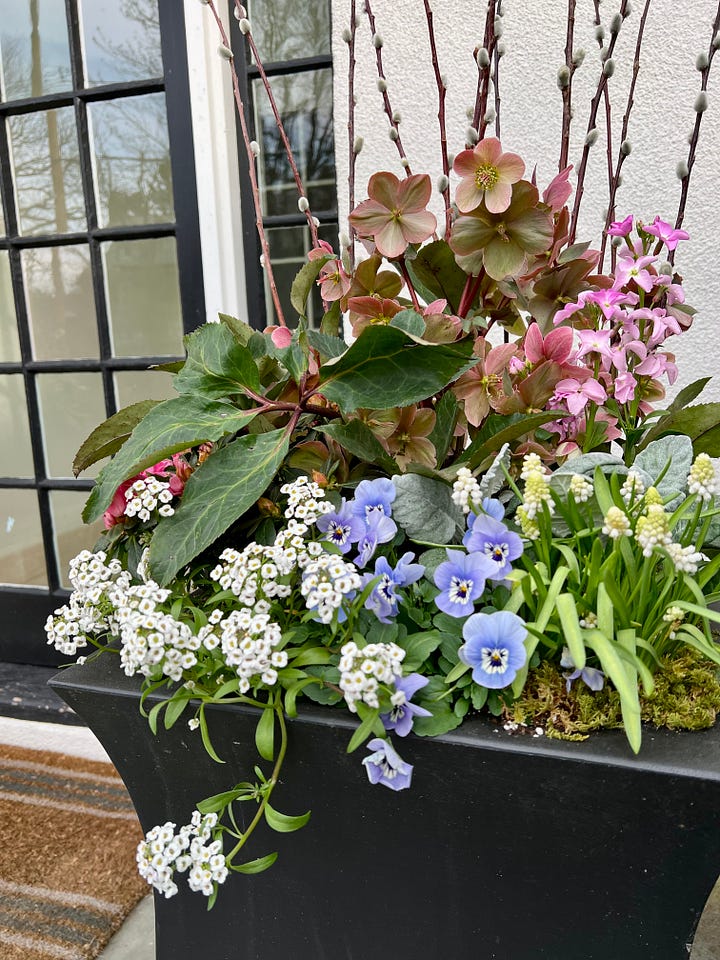
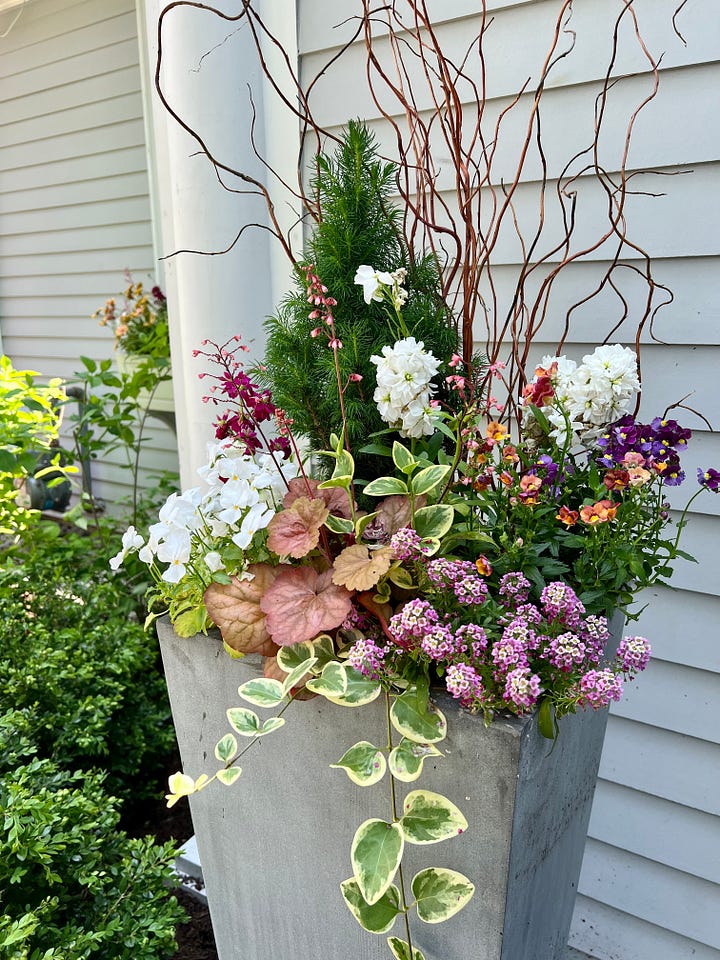
Next up - the heavy hitters - the flowers and foliage that are the real star of the show:
Violas (and pansies too) - These are the workhorses of spring plants. Super cute, come in tons of colors, and stand up to a cool night. I’m a fan of violas a bit more than pansies. Pansies can need a bit more deadheading and sometimes flop over a bit - but truly I use them both for clients and love them.
Muscari ( Grape hyacinths) - One more forced spring bulb for the list. These smaller bulbs are cool weather tolerant and long-lasting (deadhead them and you often will get a few more flowers). Also, like daffodils, once the flowers are finished the foliage can still look good for a bit longer. In shades of whites, blues, and occasionally a very light pink, they are a great addition to spring pots.
Nemesia - A super sweet cool weather annual that comes in a great variety of colors. Need a fun orange? Dark purple? Crisp white? Nemesia has you covered. They also keep going well into May filling a pot with their tiny flowers. If they start to get leggy, pinch them back for a second flush of flowers. (See them above right and bottom left)
Matthiola (Stock) - Super fragrant flowers that can keep producing their lovely tall dense clusters of blooms all spring. Like other flowers, they benefit from deadheading but besides that, they require little care. In shades ranging from white to pink to purple, they can also add a little height. (See them in both pots above and bottom left)
Heuchera (Coral Bells) - I’m adding in heuchera not for their flowers which will appear in late spring, but for their larger colorful foliage which is hard to find in early spring. When designing I’m always looking for large leaves and these are the best answer to that in April and early May. I love them in lime, coral, purple and more. Extra benefit, if your pot is in a shadier spot they can keep going all summer and into the fall. You can also tuck these perennials into your garden! (See them in both the pics below.)
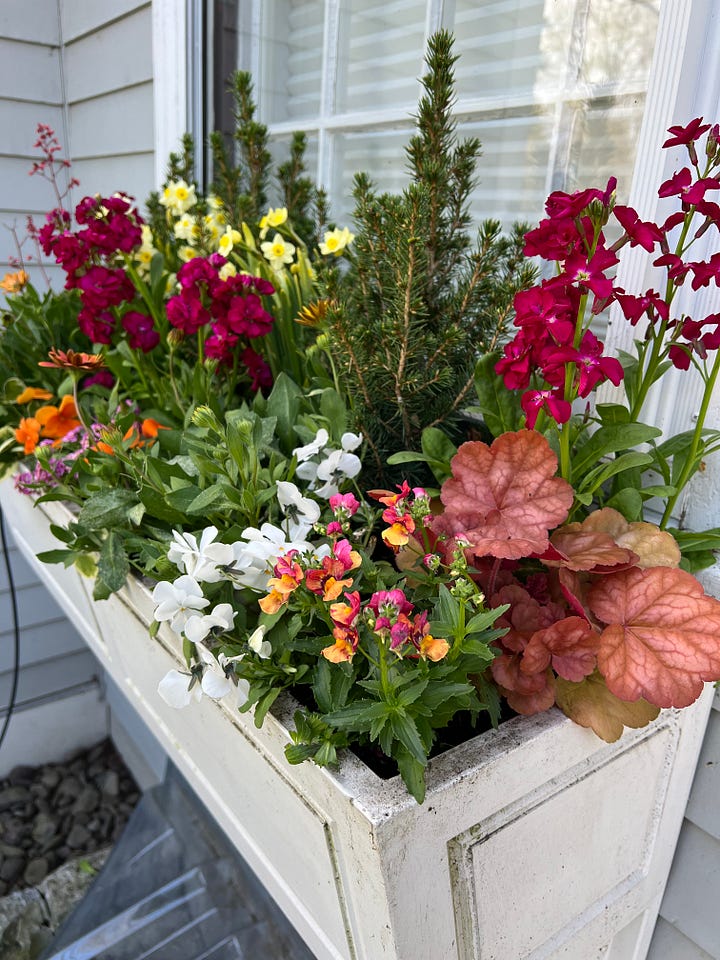
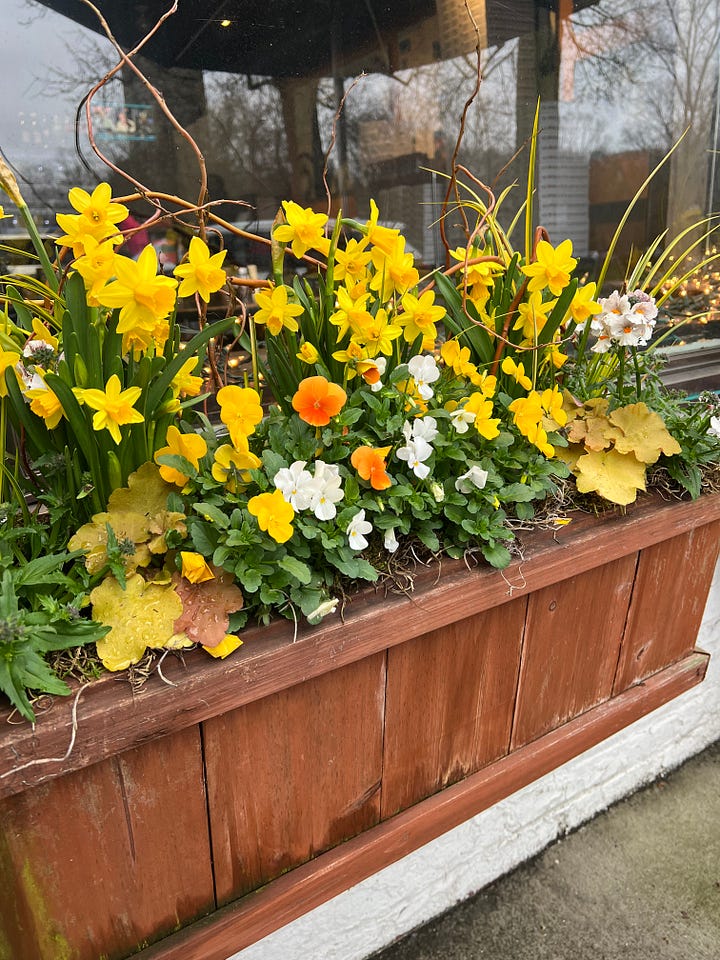
Lastly, how about some trailers? Spring has less of these so if you can’t find these tuck in moss at the edge to finish off the pot.
Lobularia (Sweet Alyssum) - Flowering trailers are hard to find in early spring but sweet alyssum is a great option. This annual’s tiny flowers are fragrant and easy to grow. If they start to look leggy after the first flush of flowers give them a good pruning and they will continue to flower. (See them in the first three pots above)
Ivy - Cold tolerant and long-lasting, I often leave ivy in my pots all season long since it is a perennial. You can use dark greens, variegated options or mid-green varieties. This is a wonderful option, especially for pots in shady areas.
Lamium - Another perennial that I love to use in the spring is lamium. This is a bonus plant as it will get lovely pink or white blooms as the season progresses. The soft light green is also a beautiful color. When you want to refresh your planters just replant lamium in a semi-shady area of your garden for a great ground cover. (See it in the bottom left pot)
BONUS ‘Plant’ - Curly twig willow and pussy willow. OK - these are not plants - but they are two of the best ways to get early season height. Since they are cut branches, a little bit of snow and an unexpected frost won’t hurt them at all. Also, occasionally, they will root and add some unexpected green foliage to your containers in late spring. (In the one pot below I used the willow for height and as a little fun edging.)
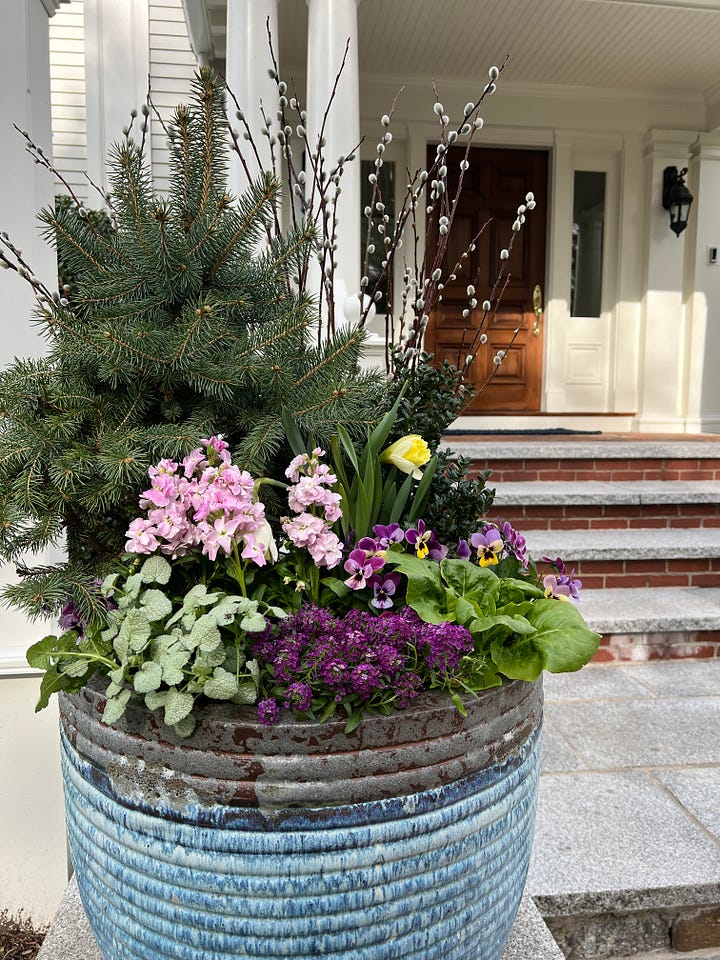
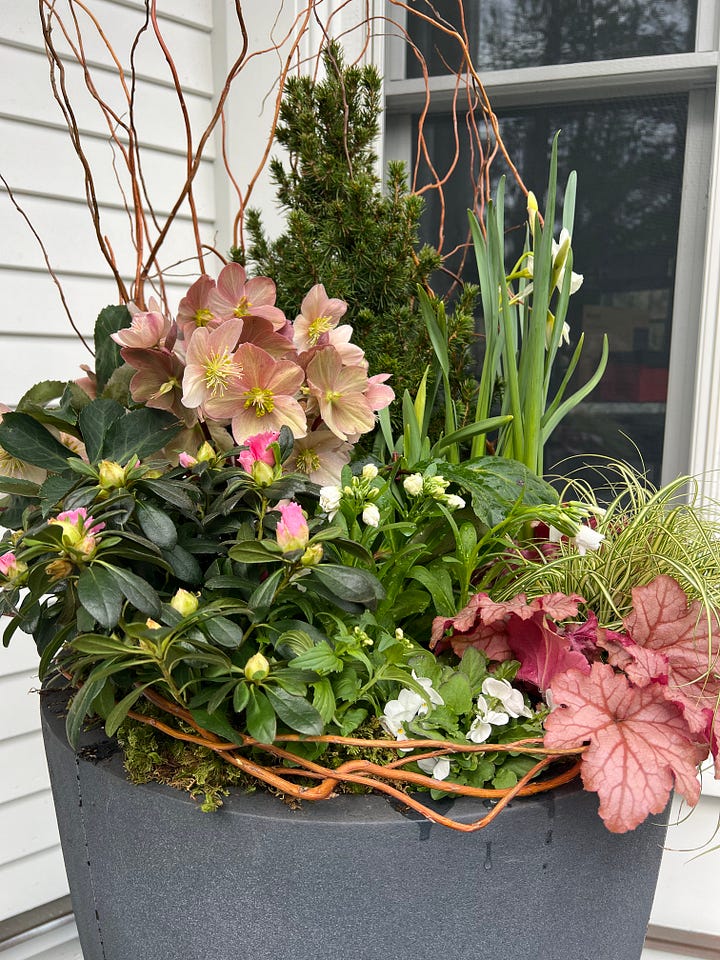
Let’s talk forced bulbs for a minute. In a garden, we plant our bulbs in the fall as they need the cool weather to trigger their internal clock. This tells them when to bloom. In some milder climates that also have enough cool but not freezing weather, you can plant your bulbs in your pots in the fall and have them bloom in the spring. If you follow many British gardeners, you’ll see them do this, and it looks incredible. If you have a similar climate to this, it is a great option. Unfortunately, here in Boston, we often have such cold winters that our pots usually freeze, and then the bulbs do not survive. If you still want bulbs in your pots, which I do, then you can use forced bulbs. These are bulbs grown in pots with a controlled period of cool temperatures (i.e., forced) so that they bloom when you want them. You can do this yourself if you have a cool area to store them (there are lots of directions on this online). Or you can purchase them from a local nursery, grocery store, or big box store. Forced bulbs will often not bloom again the following year, but occasionally, a forced narcissus will. This is because the forcing process disrupts their natural cycle. You can try planting them or treat them like an annual and compost them. Either way, I love to use them in the spring.
Happy Gardening!






Fantastic tips!! Pots always intimidate me! Thanks so much 💗
I’m so interested to see stock on this list. They are my favorite, but I find them so difficult to grow. Do you find them as seedlings at a garden center? Or grow from seed? I’ve never seen them at a garden center near me except as seed in packets.